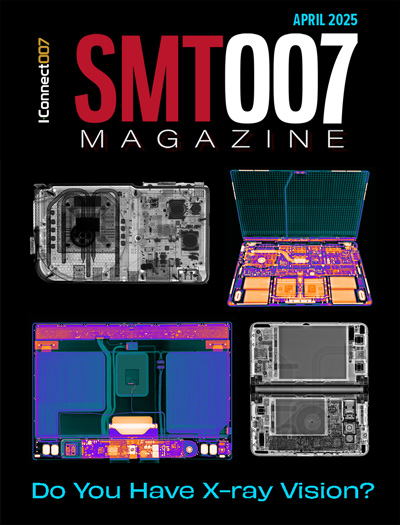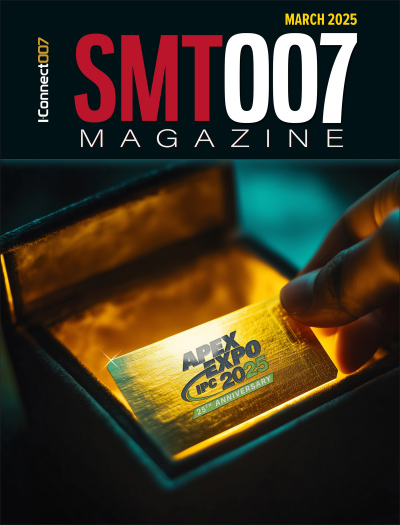-

- News
- Books
Featured Books
- smt007 Magazine
Latest Issues
Current Issue
Do You Have X-ray Vision?
Has X-ray’s time finally come in electronics manufacturing? Join us in this issue of SMT007 Magazine, where we answer this question and others to bring more efficiency to your bottom line.

IPC APEX EXPO 2025: A Preview
It’s that time again. If you’re going to Anaheim for IPC APEX EXPO 2025, we’ll see you there. In the meantime, consider this issue of SMT007 Magazine to be your golden ticket to planning the show.

Technical Resources
Key industry organizations–all with knowledge sharing as a part of their mission–share their technical repositories in this issue of SMT007 Magazine. Where can you find information critical to your work? Odds are, right here.
- Articles
- Columns
Search Console
- Links
- Media kit
||| MENU - smt007 Magazine
Tin Whisker Self-Mitigation in Surface Mount Components Attached with Leaded Solder Alloys
October 6, 2015 | By Thomas Hester and David Pinsky, Raytheon CompanyEstimated reading time: 2 minutes
Tin plating can spontaneously grow filaments, called whiskers, which can cause electrical shorts. Alloying of tin with lead (Pb) is known to suppress whisker formation. This article provides the findings of a lengthy project of soldering electronic components with pure tin finishes with lead-containing solder for the attachment. The object of the project was to determine the conditions under which sufficient alloying of the pure tin finish by lead in the solder is achieved for the purpose of whisker suppression. We have coined the term "self-mitigation" to describe this effect.
The first part of the project was planned by a committee that selected commercially available surface mount components, including package styles that exhibit a variety of solderable termination heights and lengths. The sample boards in the first part of the project were of two designs: first a simple single layer circuit card; and second, a multi-layer circuit card with internal ground planes, representing the current design practice for our production printed wiring assemblies. Sample boards were assembled using standard production pick-and-place equipment and automated soldering processes.
The original project was later expanded with multi-chip module (MCM) samples containing surface mount components with pure tin solder terminations. The success criteria for tin whisker self-mitigation was chosen to be the presence of at least 3 Wt% lead in all measured solder locations. Materials analysis was conducted in multiple locations on each solderable termination, usually at egress from the package, a midpoint, and adjacent to the board contact pad. The materials analysis was primarily performed using X-ray fluorescence, and the validity of the X-ray fluorescence measurements was checked on a sample basis with cross-sectional analysis and Scanning Electron Microscope Energy Dispersive Spectroscopy. The results have suggested that a rule based upon a sum of the horizontal and vertical dimensions of a termination be used for predicting tin whisker self-mitigation.
Introduction
Tin whiskers can grow from pure tin solder terminations, device cases, and connector shells, and risk causing electrical short circuits (Figures 1 and 2). Tin whiskers have been shown to be the root cause of the total loss of entire satellites, shutdown of nuclear power plants, and failure of consumer electronics such as digital watches.
Tin Whisker Risk Mitigation Techniques
Accepting tin whisker risk mitigation is an alternative to rejecting parts and assemblies with pure tin. Risk mitigation assumes that some level of risk must be accepted. Examples of tin whisker risk mitigation techniques include removing the pure tin by plating or solder dipping, covering the pure tin by coating or potting, or performing a tin whisker growth project on the parts in question.
Mitigation by Soldering with SnPb Solder
This is a self-mitigation or lead-poisoning technique that uses the tin/lead soldering process to add lead to the solder joint and eliminate the risk of tin whiskers. This technique has the risk of insufficient solder flow across component lead surfaces.
Editor's Note: This article originally appeared in the September 2015 issue of SMT Magazine.
Suggested Items
IPC Releases Version 2.0 of IPC-2591, Connected Factory Exchange, with Expanded Device Coverage and Smarter Data
04/23/2025 | IPCIPC announces the release of IPC-2591, Connected Factory Exchange (CFX), Version 2.0, the global standard for plug-and-play, machine-to-machine, and machine-to-system communication for digital manufacturing.
ViTrox Marks 25 Years of Innovation with Cutting-Edge Solutions at NEPCON China 2025 in Shanghai
04/18/2025 | ViTrox TechnologiesViTrox, which aims to be the World’s Most Trusted Technology Company, is proud to announce its participation in NEPCON China 2025, taking place from April 22–24, 2025, at Booth #1E45, Shanghai World Expo Exhibition & Convention Centre (SWEECC).
Indium Experts to Present on Power Electronics at PCIM Europe 2025
04/17/2025 | Indium CorporationAs one of the leading materials providers to the power electronics assembly and e-Mobility industries, Indium Corporation experts will share their technical insight and knowledge on a variety of industry-related topics throughout PCIM Europe, May 6-8, in Nuremberg, Germany.
KOKI Announces Upcoming Webinar on Solder Voiding – Causes and Remedies
04/16/2025 | KOKIKOKI, a global leader in advanced soldering materials and process optimization services, is pleased to announce its upcoming webinar, “Solder Voiding—Causes and Remedies,” which will take place on Tuesday, April 22, 2025, at 12:00 PM CDT. Jerome McIntyre, Regional Sales & Applications Engineer at KOKI Americas, will present this live session.
Real Time with... IPC APEX EXPO 2025: Transition Automation Focusing on Security Coatings and Squeegee Technology
04/16/2025 | Real Time with...IPC APEX EXPOMark Curtin, President of Transition Automation, gives an update on recent innovations at his company. He highlights a record sales month and their new focus on security coatings to fight counterfeiting. Mark explains the engineering behind their durable squeegees, the importance of maintenance, and the value of considering overall costs over just price.


